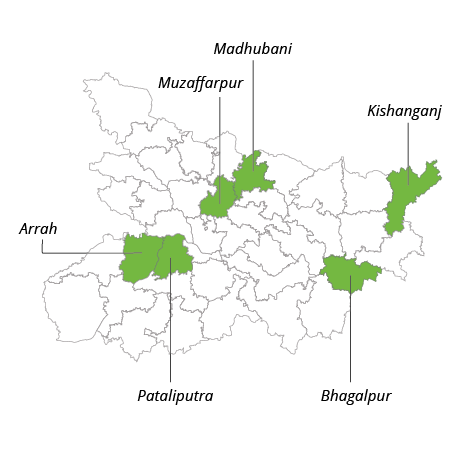
- Home
- News
- Analysis
- States
- Perspective
- Videos
- Education
- Entertainment
- Elections
- World Cup 2023
- Features
- Health
- Business
- Series
- Economy Series
- Earth Day
- Kashmir’s Frozen Turbulence
- India@75
- The legend of Ramjanmabhoomi
- Liberalisation@30
- How to tame a dragon
- Celebrating biodiversity
- Farm Matters
- 50 days of solitude
- Bringing Migrants Home
- Budget 2020
- Jharkhand Votes
- The Federal Investigates
- The Federal Impact
- Vanishing Sand
- Gandhi @ 150
- Andhra Today
- Field report
- Operation Gulmarg
- Pandemic @1 Mn in India
- The Federal Year-End
- The Zero Year
- Premium
- Science
- Brand studio
- Home
- NewsNews
- Analysis
- StatesStates
- PerspectivePerspective
- VideosVideos
- Entertainment
- ElectionsElections
- Sports
- Loading...
Sports - Features
- BusinessBusiness
- Premium
- Loading...
Premium

Regional pollsters tell a different tale from national counterparts
The results of various exit polls that were released on May 19 left the National Democratic Alliance (NDA) elated, the Opposition squirming and the general public confused.

The results of various exit polls that were released on May 19 left the National Democratic Alliance (NDA) elated, the Opposition squirming and the general public confused. The surveys, conducted by news organisations and non-media agencies during the course of the election, gave rise to intense debates on their accuracy. While it is usually national pollsters, like News18-IPSOS,...
The results of various exit polls that were released on May 19 left the National Democratic Alliance (NDA) elated, the Opposition squirming and the general public confused. The surveys, conducted by news organisations and non-media agencies during the course of the election, gave rise to intense debates on their accuracy.
While it is usually national pollsters, like News18-IPSOS, India Today-Axis, Times Now-CNX, NewsX-Neta, Republic-Jan Ki Baat, Republic-CVoter, ABP-CSDS and Today’s Chanakya, that drive the narrative, the few regional polls that exist had a different story to tell. The states of Odisha and Bihar are two examples where regional polls contradict the national ones.
A majority of exit polls are conducted by national media organisations or agencies. Conducting exit polls is an expensive affair and it requires huge manpower to conduct interviews at several polling stations across the country. As a result, very few regional organisations or agencies conduct exit polls for their state.
However, in cases where regional news organisations have come up with exit polls, there is a stark difference in numbers given by them and the ones given by national organisations. For instance, an exit poll by Pratagivadi, an Odia daily newspaper, suggests that Biju Janata Dal (BJD) will win 15 Parliamentary seats, the BJP five, and others one. India Today My Axis polls, however, projected the opposite, with the BJP winning 15-19 seats, the BJD 2-6 and the Congress 0-1.
One of the things that these exit polls, like the India Today My Axis Exit poll, indicated is that the BJP may win the Parliamentary elections but the BJD is likely to win the Assembly elections in Odisha, which were conducted simultaneously, said psephologist Ravi Das to The Federal. In other words national party gets its votes for running national parliament and the regional party the state Assembly — a neat separation of powers.
Another psephologist, Pratha Das of Chanakyya, told The Federal that an event where a party performs well in Assembly elections but loses in Parliamentary elections, when both the elections are held simultaneously, has never been seen in Odisha before.
In 2014, when simultaneous Assembly and Parliamentary elections were held, the BJD won a majority with 117 seats in the former. It secured 43.9 per cent vote share. The Congress (26 per cent vote share) and the BJP (18.2 per cent) got 16 and 10 seats, respectively. In the Lok Sabha elections, the BJD won 20 seats of total 21, while the BJP won just one. A similar trend was reported in 2009 and 2004.
After various glaring errors were pointed out in the India Today My Axis Exit poll, the organisation pulled down the page displaying detailed data for each state.
While Odisha is an example of how different the national and regional perceptions can be, Bihar has another story to tell.
Bihar’s figure suspect?
Even as national exit poll surveys indicated a clean sweep for the NDA with 38-40 seats of the 40 in Bihar, the local media (Hindustan newspaper and News Nation Hindi) gave the BJP-led alliance about 29-31 seats, and the rest to Congress-Rashtriya Janata Dal (RJD)-led alliance.
The constituency-wise details were not available. However, according to ground reports by The Federal constituencies like Arrah, Pataliputra, Kishanganj, Bhagalpur, Muzaffarpur and Madhubani are expected to go in favour of the Mahagathbandhan candidates.

Unlike 2014, when the election was fought among three major parties — the BJP, RJD and Janata Dal (United) — this year was a two-way battle between a BJP-JD(U) alliance and a Congress-RJD alliance, which included Upendra Kushwaha’s Rashtriya Lok Samta Party (RLSP), Jitan Ram Manjhi’s HAM Secular, and Mukesh Sahni’s VIP. The results largely depend on consolidation of votes among various caste and the vote transfer between parties.
For the NDA, the Modi narrative clubbed with development in urban pockets and Chief Minister Nitish Kumar’s policies, including the liquor ban, seem to have garnered support across the spectrum. Particularly in the urban pockets, even Yadavs — who traditionally vote for RJD — spoke about their approval of Nitish’s development efforts.
For instance, in Pataliputra, a Yadav-dominated area, many came in support of the BJP. Danapur, one of the Assembly constituencies in Pataliputra, has seen large-scale residential and commercial real estate projects, big healthcare facilities like All India Institute of Medical Sciences (AIIMS), and elevated roads connecting to Bihta (where the Bihar government proposed a new airport to decongest the existing Patna airport) coming up. The labour class expressed how they could get more job opportunities within the state because of this instead of migrating to other cities and states. Union Minister Ram Kripal Yadav has held the seat for two terms.
In Patna Sahib, actor-turned-politician Shatrughan Sinha has won twice before. But the town is not as developed as Pataliputra. As Sinha shifted to the Congress with the anti-BJP undercurrent, he was challenged by Ravi Shankar Prasad, who played a key role in getting former chief minister Lalu Yadav convicted in the fodder scam. Many voters felt Sinha’s theatrics alone wouldn’t help him.
However, in the rural areas, Muslim and Yadavs expressed that were unhappy with the BJP’s communal agenda, and the impact of demonetisation on their lives. Many felt that the BJP, through vendetta politics, jailed Lalu and, hence, they would back the RJD. That said, others opined that the charisma of the Lalu was missing during campaign and that his sons could not pull it off well.
In Nalanda, a JD(U) stronghold, Mohammad Hussain was worried about the communal divide and did not want to vote for the BJP. Similarly, a few metres away from the historical Nalanda ruins, Nithyanand Prasad, a middle-aged businessman, expressed support to the Mahagathbandhan candidate as he felt Prime Minister Narendra Modi did not keep his promises.
Variation in national poll predictions
There was also a huge variation in predictions of various national news organisations and agencies, which added to the confusion. For instance, in the case of Uttar Pradesh, the forecast for the number of seats the BJP would secure varied from 22 to 68. Even the total number of seats predicted for the NDA varied from 242-365.
This makes one wonder, is India having its own version of the ‘Shy Tory factor’ but for the other side? The shy Tory factor is a name given by pollsters in the UK to a phenomenon first observed by psephologists in the early 1990s. They observed that the share of the electoral vote won by the Conservative Party (known colloquially as the Tories) was significantly higher than the equivalent share in opinion polls. The accepted explanation was that so-called ‘shy Tories’ were voting conservative after telling pollsters they would not. This has also been observed in the success of the Republican party in the United States.
Political polling is fundamentally inaccurate in its current form. Election after election we have seen surprising results that ran counter to predictions from all the major pollsters. It is clear that there are certain voting behaviours that are seen as too socially taboo to admit to in a direct survey response — even in exit polls — but are not considered so taboo that it actually changes voting intention. Generally applied to conservatives, can the huge variation in predictions be a result of shy liberal voters? The right-wing BJP supporters seem very vocal in comparison to other party supporters.
Are exit polls always right?
The verdict was criticised by Opposition leaders including TMC president Mamata Banerjee and Congress leader Rahul Gandhi. “I don’t trust Exit Poll gossip. The game plan is to manipulate or replace thousands of EVMs through this gossip. I appeal to all Opposition parties to be united, strong and bold. We will fight this battle together,” Mamata said on Twitter.
Since these organisations and agencies use different methods to conduct the survey and select sample sizes, each of these each poll has a margin of error. There are other concerns such as confirmation bias, strategic formation of questions and caste and religious aspects that one needs to take into account. If not, exit polls may go wrong. Sometimes, however, predictions do hit the bull’s eye. For example, Today’s Chanakya correctly projected 340 seats for NDA and 291 for the BJP in 2014.
(With inputs from Prabhu Mallikarjunan, Anupa Kujur, Venkataraghavan Srinivasan, and Manoj Kumar.)

